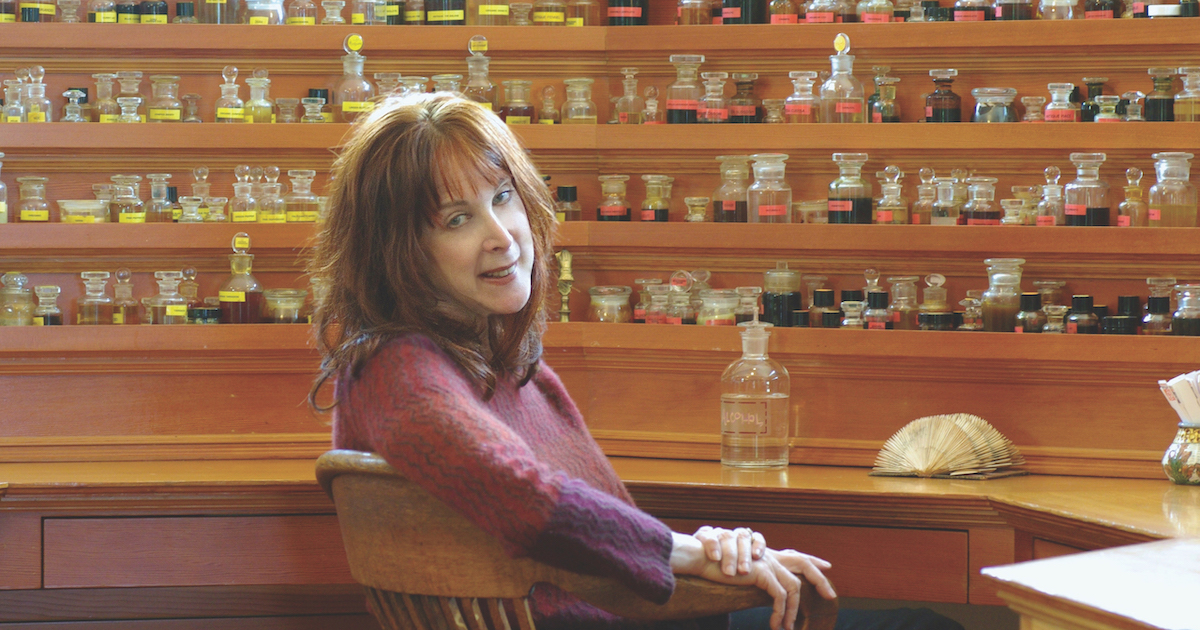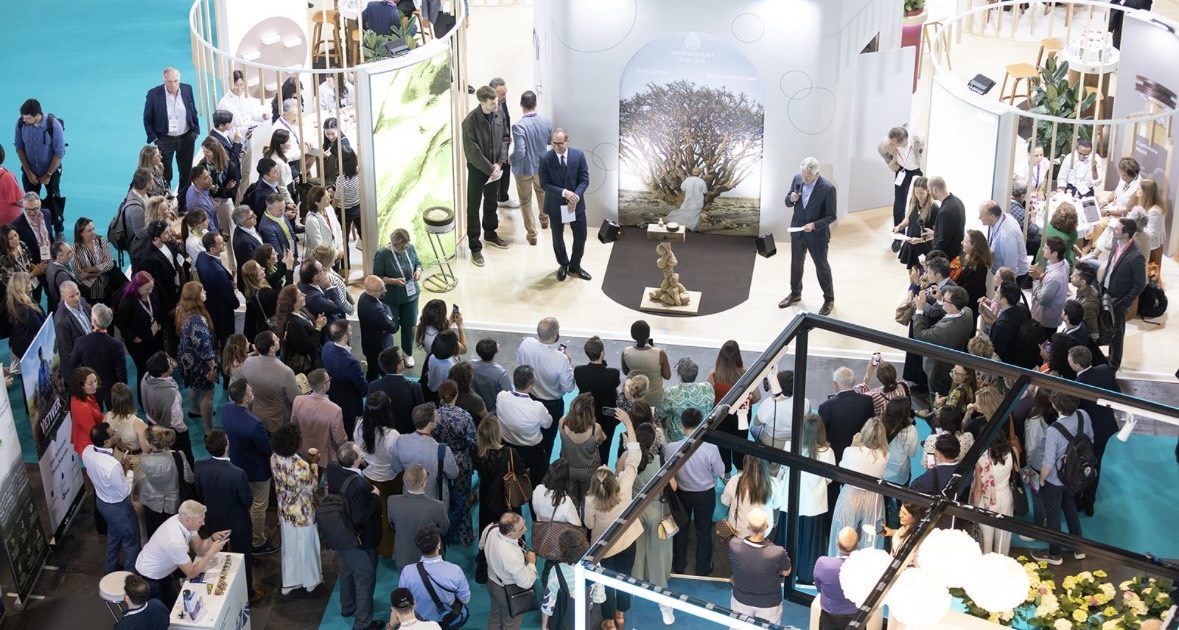Cette publication est également disponible en :
Français
American perfumer Mandy Aftel has been creating natural fragrances for 30 years and has founded her own brand, Aftelier Perfumes. A passionate pioneer who loves to share her knowledge, she is also the author of several books on perfume, including Essence and Alchemy (2001), cited by many perfumers as a reference work. She teaches natural perfumery and has created a museum at her home in Berkeley, California, the Aftel Archive of Curious Scents, which houses her collection of vintage books and raw materials sourced from around the world. She tells us how she discovered natural fragrances, how she works, and what she thinks about the current natural craze.
How did you become interested in natural fragrances?
It all started in quite a strange way, about 30 years ago. I wanted to write a novel and make my main character a perfumer, so I started researching. I like to go to the source, and I began collecting old books on perfume – I’ve got over a hundred of them. I fell in love with the books, and then I discovered natural raw materials and fell even more in love with them, and in the end I never wrote my novel. Together with a friend I created a first line of perfumes, which didn’t last long, then I founded my brand Aftelier, and in 2001 I published my book Essence and Alchemy, which was translated into a lot of languages – lots of people have said the book started them on the path to natural perfumery.
Why do naturals have a special appeal for you?
These raw materials have been around for so long, their stories are so fascinating, and they are so much a part of who we are. They are where perfumery started. And they are such gorgeous, complex and interesting ingredients.
How did you get trained?
I trained myself, because no one was studying natural perfumery at the time! It just wasn’t possible. I started trying to understand how to make these essences work. They are very difficult to work with because they are like little perfumes in their own right. I was very attracted to their facets and the almost architectural way you put them together. Later I developed a method to train people to work only with natural essences, and I myself am still learning: every time I get a new ingredient, I train myself. The learning process is endless.
What do you say to people who find natural fragrances too simple, too raw, not complex enough?
I agree with them – in some cases. I say it all the time: mixing a bunch of natural ingredients in a bottle does not produce a perfume. Creating a good perfume is an art. The creation springs from an understanding of the materials, their facets and how they fit together. If that’s not something you’re aware of, what you do can very quickly become a mishmash of naturals. I’m a perfumer, not an aromatherapist, and natural fragrances are not aromatherapy blends, which smell very medicinal to my nose.
There are many definitions of natural perfumery: what raw materials do you use for your creations at Aftelier?
I use essential oils, absolutes, concretes, CO2 extracts and natural isolates – not biotech molecules ; I know they’re considered natural, but I don’t find them interesting. My formulas only contain ingredients that come from plants or, in some cases, animals. I buy them myself, and I’m very strict about sourcing. I only use and sell what I think is the very best. The more beautiful the raw materials are, the more beautiful their facets will be, as will the final product. It’s a real quest, which I love. In the early days of my brand, I used a Moroccan rose which I eventually replaced with a Turkish rose I thought was better. This forced me to reformulate all my fragrances, but I could afford to do it because I work in an artisanal way. It also means I can use extremely expensive raw materials. A few years ago I used to buy gardenia from a particular producer – I think I was his only customer! It cost a fortune. One of my perfumes is built around four ingredients, each of which costs more than $10,000 per kg: orange blossom absolute, ambrette absolute, ambergris tincture and osmanthus absolute. When I buy isolates, I also pay close attention to the raw material they come from.
What do you mean?
They vary a lot depending on the original raw material! At first, I worked with coumarin from the cassia [Cinnamomum cassia], then I discovered that the one that comes from the tonka bean was much better. Of course, it’s still coumarin, they’re similar, but it’s all in the details because they always reflect aromatic facets of their original source. The one from the cassia is rougher, sharper, whereas the one from the tonka is softer, rounder, more powdery. So with the tonka you obtain better softness, and softness is one of the reasons you use coumarin. What I like about natural isolates is that they allow you to add a facet to the other ingredients, because they’re less complex – it’s like what you do with synthetics in conventional fragrances. They can also add staying power to natural fragrances, which is an issue for many consumers. I use a lot of methyl anthranilate, which smells like orange blossom and grapes, vetiverol, which is a cleaner vetiver, geraniol, phenylacetic acid, which smells like civet, and octanol, which is obtained from wild mint and lets me add a clean mushroom facet. And I love ambrettolide, which is a very important addition to the natural perfumer’s palette, because it reminds me of the clean white musks that are used a lot in synthetics but don’t exist in nature.
How do you develop your formulas?
I always proceed in the same way, which is also the method I teach. All my perfumes begin as conversations between two raw materials that generally contrast strongly with each other. My work is very structured, and this relationship is the basis for expressing the feeling, the experience I want to convey. Then, when I start adding ingredients to the formula, it’s quite open to begin with and then by the end there are very few options left. Each essence has to be the best at what it does within the formula and be really necessary: I never use an ingredient just because I like it or because I think it might be interesting. That’s how I work, how I teach and how I think.
Can you tell us about the creation of one of your fragrances?
My favourite fragrance is always the latest! Violet ambrosia centres on broom and alpha ionone isolate, a violet-scented note. The fragrance is meant to evoke a violet warmed by the sun, rather than in the shade. To maintain the connection between my two principal materials, I used ingredients that share tones with violet, such as vanilla, coumarin and ambrettolide. They don’t interfere with the violet, which remains dominant. The rest is a bit more musky, sweet, powdery. The heart features a lot of old honeyed broom essence. In my formulas and in my museum, there are lots of essences that are 20 or 40 years old, that have aged like fine wine and are extraordinary. When producers have a stock of unusual natural essences, they come to me and I buy them! I also used ylang-ylang concrete, which is my favourite of the extracts of the flower , creamier, spicier, richer, and which combines beautifully with the broom. And finally, I managed to find sandalwood CO2 extract which adds a creaminess and woodiness to the top note. Sandalwood often tends to be lost in the base because it has no top notes of its own, but the CO2 extraction allows you to achieve this effect.
You write books, you teach courses, you have opened a museum. This approach to transmission is quite unusual because perfumery is a very secretive environment? Why is it so important for you?
I like to share, and I’ve got nothing to hide. Since I opened the museum, thousands of visitors have come from all over the world to discover the perfumer’s organ, the books and old maps, and to experience the raw materials. Seeing them happy as they enter this universe makes me happy.
As a pioneer in this field, what do you think of the current craze for natural perfumery?
People write to me every day to say that my book has been important to them. It’s lovely and surprising because I didn’t follow a plan, I just did what I enjoyed doing. These days consumers have a real appetite for naturals, but when I started the world of perfume was very different. It’s much easier now to be a natural perfumer, especially thanks to the Internet. I haven’t sold in shops for a long time, only on my website, which allows me to have a real relationship with my customers, and that’s something I love: they write to me, I put a little note in with each order. I’d be unhappy if I couldn’t work like this. My perfume bottles are small, the classes I teach are small, everything is small! I learn and have fun every day. Today, large companies are interested in natural perfumery, but I don’t think natural perfumes are good for big brands : they are products that should remain artisanal.
—
- Aftelier Perfumes website: www.aftelier.com
- Follow Mandy Aftel on Instagram: www.instagram.com/aftelierperfume/
Natural perfumers – Summary
- Introduction, by Jeanne Doré
- Hiram Green: “If people want to buy my perfumes, it should be because they like their smell“
- Caroline Dumur: “Without synthetics, you have to learn to formulate differently”
- Delphine Thierry: “To formulate 100% natural perfumes, I set aside almost everything I’ve learned so far”
- Isabelle Doyen and Camille Goutal: “For us, 100% natural is a perfumer’s challenge rather than a marketing position.”
- Serge de Oliveira: “Most clients want natural perfumes that are just like conventional fragrances”
- Irène Farmachidi: “In 100% natural perfumery, we formulate by using paraphrases, it’s like a game”
- Mandy Aftel: “Mixing a bunch of natural ingredients in a bottle does not produce a perfume”
- Our selection of natural perfumes
- The many facets of natural perfumery
- Natural perfumes: conclusion and a few thoughts








Comments